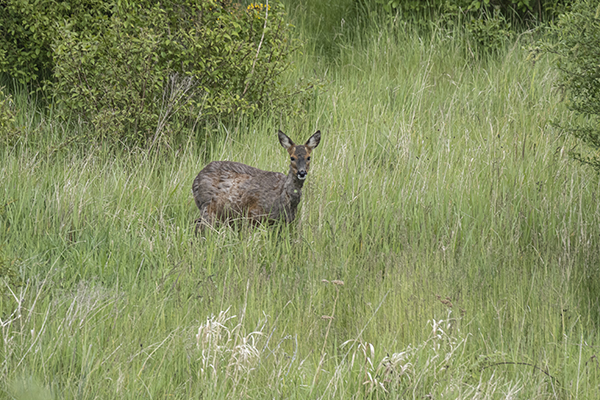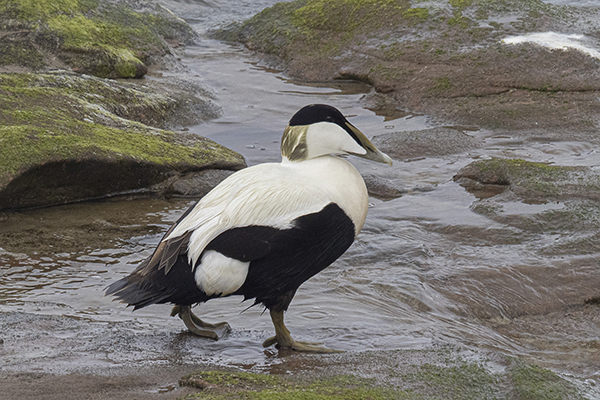I was on Hilbre on a bird-less and blustery May morning, wondering when the weather was ever going to improve, when a chance message from Fred changed my plans for the rest of the day. He'd decided to go for an adult Franklins Gull that had been displaying to Black-headed Gulls at St Aidans RSPB reserve near Leeds. This reserve was formerly an old opencast mining site that was flooded after the adjoining river bank collapsed in 1988.
I saw my first Franklins Gull whilst still at school in Suffolk in November 1977 when a 2nd winter bird spent a few days at Lowestoft - I also saw my 1st Glaucous Gull, Purple Sandpipers and Little Auk the same day!The Little Auk flew over our heads, inland, with a flock of Starlings. Since then I've seen several more with one in Kenysham, Bristol on a flooded playing field and one following a plough in Cornwall. They're probably the most attractive of the American vagrant gulls and as the journey was only a short one with the promise of a few other nice species I jumped at the offer of a lift so headed off Hilbre and joined Fred at his office just off the M56 where we were joined by Malc.
We arrived in good time and parked up to admire the wetland vista in front of us. There were birds everywhere and the whole site was teeming with lapwings and numerous species of duck, warblers and grebes. The skies looked ominous and we had some terrific cracks of thunder accompanied by forked lightning.
Walking to where theFranklins Gull had been showing we were pleasantly surprised to find it was one of the closest birds to us! Much closer than any of the other Franklins I'd seen (the Lowestoft one was on the roof of a port building). It occasionally flew round before settling again but eventually flew off to the opposite side of the reserve out of view.
 |
| Franklins Gull |
Nearby my attention kept getting distracted by a pair of Common Terns with the female sat on a fence post calling until the male presented her with a small fish or newt as part of their pair bonding.I'm pretty sure my wife would prefer to be presented with a G & T rather than a slippery amphibian or fish.
 |
| Common Tern - I'd never noticed the yellow tip to the bill before. |
With booming Bitterns, pinging Bearded Tits and the soft chatter of Reed Warblers accompanying the 'zit, zit, zing' of Reed Buntings it really was a feast for the ears compared to my impoverished inland home patch.
 |
| Male Reed Bunting singing |
Judging that the surrounding rain showers would pass us by we decided to walk further into the reserve to look for one of its rarer inhabitants. Black-necked Grebes breed at Woolston Eyes in Cheshire but are generally quite distant. Here at St Aidans several pairs breed and can be see nat close range from some of the footpaths dissecting the site. This smart looking grebe is migratory and returns every spring to the UK to breed before heading off again in the autumn to warmer climes.
We were lucky enough to find several birds feeding well grown young and close enough to see their main prey was newts! That eye colour! They're incredible looking birds and like all grebes were heavily persecuted in the past for their plumage for the millinery trade.
Black-necked Grebes split parenting duties and when the young are a few days old each parent takes responsibility for one or two (depending on brood size) of the youngsters until they become independent.
 |
| Black-necked Grebe |
Great-crested Grebes are another species that was persecuted for fashion industry and they hold a special place in my memories of my late dad. As a kid they were till quite scarce and I remember a pair breeding on a local gravel pit when we lived in Essex in around 1968 (just before we moved to Suffolk where my birding education really started). I'd just got my 1st ever pair of binoculars - a pair of Prinz 8 x 30 - for either a Christmas or birthday present (or probably a combined present as I'm one of those unfortunate people whose birthday is just after Christmas and New Year) and dad took me to see these wonderful birds that had been found by another birding influence in my early life Mrs Jo Herriott. Mrs Herriott used to have Robins feeding from her hand and reared a brood of orphan Blue Tits and had photos taken in the mirror of the recent fledglings pulling her hair pins out! Anyway, enough reminiscing, St Aidan's also has a healthy breeding population of Great-crested Grebes. Again, this is a species I regularly see on the sea at Hilbre but usually distant.

Our window of opportunity to bird without getting wet was decreasing every minute and with storms now surrounding us we headed back towards the car park - just in time as the heavens opened! We still had time for another goodie though when I spotted a Roe Deer feeding, unconcerned by the number of people using the footpaths, in a fenced area.
What a great reserve and a credit to the RSPB sand the people who manage it. Hopefully I'll be able to visit again in the future. It was nice to see so many people making use of the reserve who weren't necessarily bird watchers but were just out for a walk in the countryside. To me this is one of the keys to helping safeguard our wildlife - engaging people with the countryside.
 |
| Male Pochard |












































































































